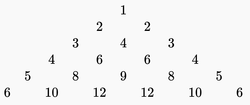Abhishek's Triangle
 The sum of elements in
th row is given by
, while the sum of elements in
consecutive rows starting from the first row is given by
.
The sum of elements in
th row is given by
, while the sum of elements in
consecutive rows starting from the first row is given by
.
If , find the positive square root of digital sum of .
Digital sum of is equal to sum of digits of .
Digital sum of .
This question is part of set Serieses are fun! .
This section requires Javascript.
You are seeing this because something didn't load right. We suggest you, (a) try
refreshing the page, (b) enabling javascript if it is disabled on your browser and,
finally, (c)
loading the
non-javascript version of this page
. We're sorry about the hassle.
f ( n ) = ∑ r = 1 n r [ n − ( r − 1 ) ] = 6 n ( n + 1 ) ( n + 2 )
g ( n ) = ∑ r = 1 n f ( r )
s = f ( n ) g ( n ) = 4 n + 3 .
Hence, s = 4 2 0 1 3 + 3 = 5 0 4
Digital sum of s = 5 + 0 + 4 = 9
Square root of "digital sum of s" = 9 = 3